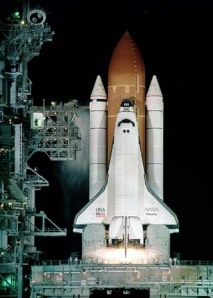In today’s class we learned about the physics of rocket flight by watching a 30 minute video that explained how the Space Shuttle and Saturn V rockets worked. The students made notes in an Astronaut’s Log Book about any interesting facts they saw during the videos, and any questions they had about what they saw. At four points during the movie we stopped the video to give students a chance to share what they observed and ask questions. Students noted the following interesting things about the space shuttle:
- The space shuttle uses five engines to lift off. Three are attached to the shuttle itself, and fed by a huge external fuel tank attached to the shuttle’s belly. After the shuttle reaches space, the external tank is cut loose and crashes into the Indian Ocean. The other two engines are attached to the booster rockets that appear on either side of the main fuel tank. (See the picture below.) The booster rocket tanks use parachutes to fall back to the ocean, where they are recovered and used again.
- Most of the shuttle’s mass at the time of launch is the fuel needed to propel it into space.
- The main fuel tank is filled with liquid oxygen and liquid hydrogen. When they react, they produce water vapor. The booster rockets use a solid fuel.
- Once the booster rocket engines are started, they cannot be stopped.
- The shuttle does not take off going straight up. It moves away from the Earth in a curved path as it establishes a circular orbit about the Earth.
- The shuttle launches from Florida toward the East to take advantage of the Earth’s rotational velocity, since Florida is close to the equator. The European Space Agency launches from South America, at a location that is even closer to the Earth’s equator.
- The shuttle’s three main engines are pivoted to direct the rocket thrust in just the right direction at take off.
- A few seconds before take-off, over 300,000 gallons of water are released onto the launch pad to suppress the noise created by the engines. Otherwise, the sound energy would reflect off the ground and damage the shuttle.
- A few minutes after take off the shuttle breaks through the sound barrier. It has to slow down a bit when doing this to reduce the stress on the ship.
- The booster rockets are cut loose a few minutes after take off. Later, the main fuel tank is also cut loose.
- It takes only 90 minutes for the shuttle to orbit the Earth, at an altitude of 400 km.
The students asked many interesting questions:
- Where do they keep the food for the astronauts? (Answer: I don’t know its exact location–but shuttle missions last too long to send the astronauts up without food and water, so it’s kept somewhere!)
- Why don’t the booster rockets and main fuel tank “float” in space like the shuttle? I.e., why don’t they orbit the Earth? (Answer:The booster rockets are cut loose while still in the Earth’s atmosphere, so air resistance slows them down and parachutes are used to provide a soft landing in the ocean. The main fuel tank has a small valve near the top that releases pressurized gas when it’s cut loose, causing it to tumble back toward the Earth—otherwise it will skip off the atmosphere and become a very large and dangerous obstacle in space!)
- Why doesn’t the shuttle use jet engines? The student pointed out that jet engines are easier to build. (Answer: At high altitudes, the decreasing air pressure and temperature will result in decreasing thrust from a jet engine. In space, a jet engine wouldn’t work at all.)
The last part of the video discussed the enourmous Saturn V rocket, which generated a massive amount of thrust to lift the Apollo astronauts into space on the way to the Moon. We learned about the three stages of the Saturn rocket, and how the astronauts orbited the Earth 1.5 times before the final engine burn produced the necessary velocity (about 11,000 m/s) needed to send the astronauts toward the Moon. The journey to the Moon requires four days. Nearly 98% of the Saturn V mass consists of fuel!
In the final minutes of the class, students learned about the general trajectory of the Apollo rocket toward the Moon. We learned that since the Moon is orbiting the Earth, the rocket cannot be launched directly toward the Moon. Sending the rocket to the Moon is kind of like playing catch with someone who is running while you are throwing the ball to them.
Tomorrow: We begin work on our computer programs.
